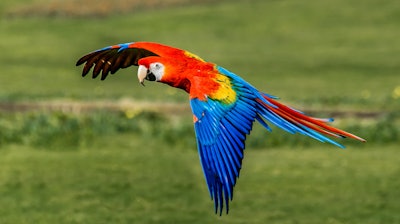When you look in mirror, is that what others see? Typically there is some distortion. Dan Silvert, president at Velocity Advisory Group, explained at the 2021 PDA Annual Meeting, “In a crisis, that becomes magnified—you need clarity so you know how it is you’re coming across in first place.”
This requires high levels of self-awareness, so that if you’re blunt, you can tone down your messaging when speaking with someone more sensitive. Ultimately, self-awareness leads to healthier relationships, trust, and performance.
Silvert describes four main types of people: eagles, parrots, doves, and owls. Many of us fit a secondary style as well or have parts of each style. Each has a fundamental focus and what makes them tick.
- Eagle – Results-driven, eagles prefer direct, blunt communication. They embrace conflict and respond to confidence in others.
- Parrot – Parrots are fun, positive and like to discover what’s possible. Even in a crisis, they are likely to be social and communicate, searching for the silver lining. Parrots are motivated in crisis, realizing it’s not “just about them.”
- Dove — They foster harmony and tend to be preternaturally calm, patient, and sincere. Because they are so committed to promises, they are not quick to make them. They are generally averse to conflict and are very in-tune with the group’s dynamics.
- Owl — A fundamental focus on accuracy and data drive owl styles. They like to put data into systems, and analyze it to arrive at the most accurate conclusion. “For many of you, it’s the oxygen you breath in pharma manufacturing,” said Silvert.
Each type has specific ways of communicating, receiving information, and responding to crises. What a dove might call a conflict, an eagle might call conversation. A parrot sees perfectionism as the enemy of innovation and moving forward while an owl is focused on moving slowly to avoid making mistakes.
[Editor's Note: This form of taking others into account comes more naturally for some than others. For decades, industry often overlooked the contributions of those with predominately owl and dove styles, but it is heartening that more and more value is being placed on all types of people who are needed to get through crises and innovate in "normal" times.]
Q&A on crisis communication
After his presentation, Silvert sat down with the following panelists to discuss their perspectives around this empathetic style, moderated by Susan Schniepp, distinguished fellow, Regulatory Compliance Associates Inc.:
- Michael N. Blackton, MBA, vice president, quality, Adaptimmune LLC
- Richard M. Johnson, MSc, president and CEO, PDA
- Mary Oates, PhD, senior vice president, global quality, Emergent Biosolutions
[Editor’s note: Questions and answers have been edited for length. To view the full presentation and panel which are available for 60 days, register for the PDA Annual Meeting here. ]
Susan Schniepp: Why is customizing the message so important?
Dan Silvert: Adapting to the right style at the right time is a wonderful way to build trust, especially in a crisis because you're speaking their language in their tone, in a vocabulary that makes sense to them. So they don't have to adjust to you. You are in fact adjusting to them. That's one of the hallmarks of leadership—the leader should be sweating more than the followers. Our job is to bring out their best in other people. So to the extent that we lean in their directions and speak their language, they can freely give us their best thinking.
Michael Blackton: Looking back in my organization, when COVID-19 hit, we didn't have a specific process to deal with that. But what we did have was trust among the management team. We were able to get through the initial parts of this crisis very effectively without that defined process, because of that trust driven by an understanding the perspective of the other people on the team.
Mary Oates, PhD: When I was much younger in my career, I would put my ideas out there, but it seemed they would never land… nobody would take it up and run with it. I talked to someone I trusted who had a lot of experience with these sorts of things. She said something that I have always remembered, and it fits really nicely with what we're talking about today. “Mary, you can still say what you need to say. You can still get your point across, but sometimes you need to wrap it in a different type of wrapping and tie it with a different type of bow.” And what I took away from that was that I could still make my points, but I needed to adjust to my audience so that they would hear me better. And that's something that I've always kept in my mind that I need to think about the audience so that they'll hear me better and we'll be able to work better together.
Richard Johnson: Understanding that everyone doesn’t interpret a message in same way is key to being effective. When there's a crisis, especially in a professional setting, that's when it's very important for us to be even more careful about how we do that because our predispositions, our personalities have the potential to come out when we're not guarded enough. If we want to be effective, we have to filter that a little. We need everyone to be pulling in the same direction and that's the most important in a crisis.
Schniepp: Dan, when companies don't manage their messaging and don't customize it, what have you seen happen or how does that play out for them?
Silvert: Let's say you have an organization that the leadership team is predominantly eagle-owl there. They're highly focused on executing, and executing correctly. So they pump a lot of eagle-owl oxygen into the organization. That is what is valued. Meanwhile the parrots and doves can't breathe, and then the eagles and owls are wondering, “Hey, what's wrong with these folks? Oh, they must be bad hires.”
Smart organizations—healthy organizations—they pump oxygen for everyone to breathe so that people can volunteer their best thinking and their best efforts. And this is difficult, again, it's the leaders that need to sweat here. Match the moment, not the mirror. And hopefully your populations will lean back towards you.
It's supposed to be a two-way street. But leaders need to be very conscious and aware that it's just not about you, it's about them. To the extent that you feed them the oxygen they need, they're going to give you more. They're going to be resourceful, innovative. They're going to volunteer their best efforts. They're going to surprise you. They're going to surprise themselves. Why? Because you unleash them. If you force other people to breathe your oxygen, you'll get compliance. They'll do what they can, but you're missing out on that hidden potential. That potential is not just hidden from you, it's hidden from them. We’ve see that a crisis itself brings surprising strengths we didn't even know we had. Why is this surprising to us? Because we never had the opportunity to display it. And that's what a leader should be doing. Giving you the opportunity to surprise yourself.
Schniepp: When I've managed in crisis, what I found is if I do not customize the message to appeal to all types, what I end up is with people filling things in… like it’s a jigsaw puzzle and I've only given them the edges of the border of the puzzle. They start to fill in the picture and usually it's quite inaccurate and that creates more consternation and anxiety among the staff. From my perspective, if you don't customize the message, you end up with people filling in details and rumors. The grapevine works incredibly fast and those missing pieces they’re trying to fill in just fly around the company and they're oftentimes very in accurate.
Blackton: A good example is email practices where you could say something that when you read it is unambiguous, but to the person that doesn't have your background, it's very ambiguous—ambiguity is really the enemy of efficiency, right? It's the enemy of getting things done. So I pick up the phone now and I talk to people and we have a conversation.
One of the things that Dan said is you can unleash people. You can give them and yourself the opportunity to surprise yourself. We saw this and the response to a crisis at Adaptimmune. It is amazing the ownership, the drive, the enthusiasm you get when you unleash people. And part of it is understanding their perspective.
Johnson: Adapting our messaging to the audience is a lot easier to do in a conversation than it is in a document. I agree with you a hundred percent.
One of the challenges that we've all been dealing with as part of this pandemic with remote working is it's been that much more difficult to have those kinds of very simple face-to-face conversations that we in a normal environment we can take for granted.
So we are relying a lot more on other types of communication right now. But I think it's important to remember that, from a pure efficiency standpoint, I can send out one message to everybody in my organization, write that email fast, quick, it gets to everybody. But it doesn't allow you to do the things that we've been discussing, which are trying to understand the motivations and the ways that different people are going to respond to that message. So I think it's very important to have those kind of verbal communications and if possible, face-to-face communications, because it's not just the words you use, it's also your being there, the body language.
Oates: I would echo what Richard was saying about the challenges that the pandemic has placed in terms of how we communicate with each other. I believe I fall into the eagle category and one of the things that has been really challenging for me is when I can't see people and I can't see their reaction and how they're engaging with me, I have found that I can be more and more eagle like. So one of the things that we have done where I work is essentially requiring that people use their cameras for meetings. And I found that for me, that has really enabled me to dial my eagle down and be more on the supportive side, because I can see and interact with people.
Schniepp: I’m fascinated with how email gets misinterpreted. Can you give us some perspective on the different management styles and how they react to email, and what you need to watch in your emails to make sure you're communicating appropriately with the parrot, the dove, the owl and the eagle?
Silvert: That's a great question. If you find yourself carefully crafting an email because you're instinctively cautious about how it might be received, don't write it. That is your warning sign to pick up the phone or schedule a Zoom meeting. Emails should not be used for anything but asking questions, conveying factual information, and compliments. Anything outside of that is dangerous. Why? Because the tone in which you write an email is very unlikely to be the tone that the email is read in.
This is just something that we don't typically think about, because when you're writing the email, you have a tone in your mind, you can hear your own voice. As soon as you hit send, you think that’s what's going to be conveyed. Not so.
Someone's going to pick up that email. Maybe they just had an argument with their son, they've got something going on, or they may be in any myriad of situations, they're going to read that email in a tone that is different than the one you wrote it, which is why you need to be very careful.
Now having said that, if you're going to write a company-wide email, use the birds:
- The first line of the email is for the eagles. It's the bottom line, the purpose of the email.
- Second paragraph is for the parrots—what's fresh, interesting, or unique. And how it might impact the reader.
- Third paragraph for the doves: How does this impact the community? “If we go down this road, here's some things we need to be thinking about,” for instance, and that activates the dove's muscles around how messages can be conveyed and how they can be adopted.
- Then save the last part of the email for the owls, which is just the data, the validation behind it, the procedures that you’re going to employ, and here's how we arrived at those procedures.
Please know that your eagles and parrots will not read it. They're going to go to the first line, maybe the second paragraph, and they're going to be gone.
By the way, take that concept the next time you get up in front of a group of people and you're giving a presentation. Take a look at your PowerPoint and say, “Which are the eagle slides? What are the dove slides? What are the parrot slides? What are the owl slides?” and make sure that you speak to those four groups because otherwise you’re likely to give the presentation in your style, whatever your style happens to be. Your presentation will be stronger because it will land on an individual level, which is what you're trying to do.
Blackton: It brings back a story from years ago at a small company. Even if you just wanted to know the time, there was somebody working there that would send an eight paragraph email. This person never got their point across since the company management was full of eagles—nobody understood him. Very frustrating for him, and for us.
Susan: And how do you keep this up in crisis, or beyond?
Oates: It can be difficult to change your style in a lasting, consistent way. You may revert after some conscious change, particularly in times of stress. It can be helpful to ask colleagues for feedback.
Blackton: A 360 review helped me a lot. I echo what Mary, said you have to keep working at it. One refreshing thing that helped me with owls… throw out the eagle, go all dove. It drives ownership. They’re working to their best, my job as leader to bring that out in positive way.
The 2021 PDA Annual Meeting is full of on-demand content on aseptic filling, flexible facilities, vaccine considerations, cell therapies, and more. Presentations and Q&A videos will be available through May 16, 2021. Register here.

























